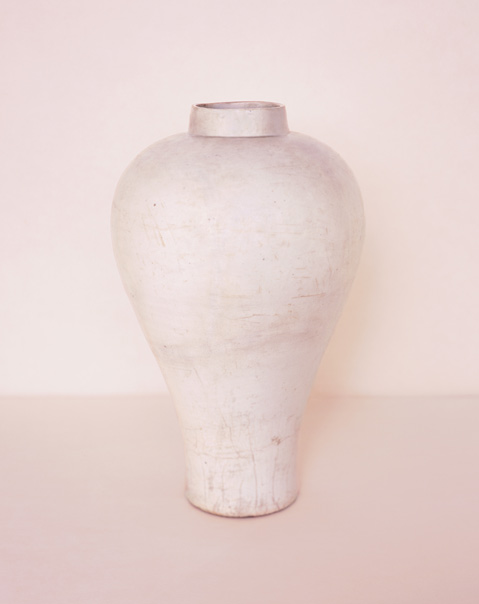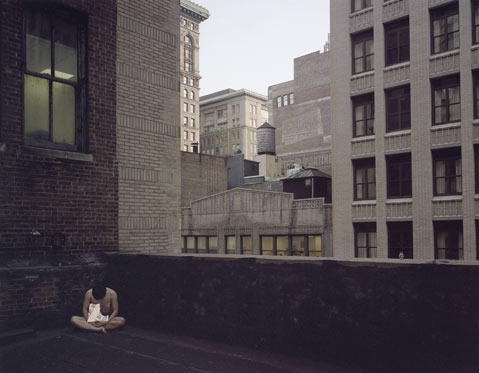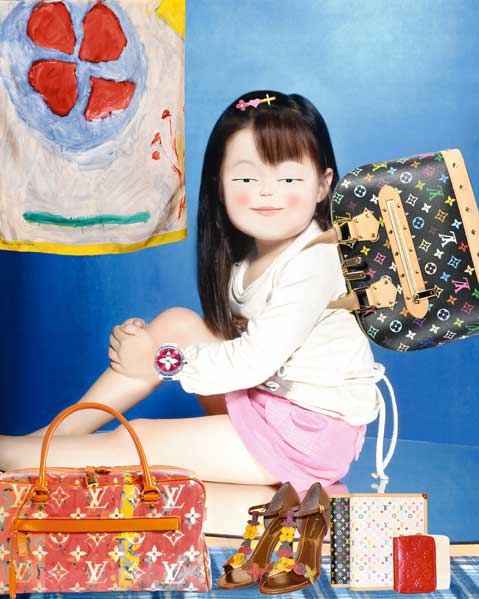Contemporary Korean Photography at the Santa Barbara Museum of Art
Forty Korean Artists Working at the Limits of the Photographic Medium

Like a beautiful vase, successful art implies two separate yet complementary modes of understanding. From one perspective, what’s important is what’s inside the vessel — how the work of art holds and conveys its content. One might term this the perspective of realism, or of art as representation. But from the other angle, the perspective of art as expression, what’s important is how the work transforms our understanding of what’s outside the container: what impact the work has on how we see the world around it and what kind of statement it makes about the place and time in which it is found. As the poet Wallace Stevens put it in his “Anecdote of the Jar,” describing the expressive impact of the artwork on the beholder’s perception of the world, “The wilderness rose up to it / and sprawled around, no longer wild.”
In an important new exhibition at the Santa Barbara Museum of Art, curators Karen Sinsheimer of the SBMA and Anne Wilkes Tucker of the Museum of Fine Arts (MFA), Houston, have brought together works by 40 contemporary Korean photographers, all of whom in one way or another test this boundary between the representational expectations that photography typically engenders and the expressive potential of photographic practices conceived in the broader context of contemporary art making.

The most distinguished of these photographers, Bohnchang Koo, participated in the process of curating the show and traveled to Santa Barbara to speak at the museum on the occasion of its opening. Koo’s work, in particular his series of images based on the Korean porcelain ware of the Joseon era, embodies the highest possible aspirations for photography as 21st-century fine art. Looking back on the cultural traditions of his homeland and encompassing more than a century’s worth of international art history in relation to the dialectic of figure and ground, Koo’s breathtakingly beautiful images reveal a profound engagement with the most fundamental premises of aesthetics.
The exhibition, titled Chaotic Harmony: Contemporary Korean Photography, will be on view at the SBMA through September 21. It’s a major step forward toward a new, more global vision not only for the museum but for the city, as well. I spoke with curator Sinsheimer last week about the works and about the experience of putting it together over the course of several years and multiple trips to South Korea.
Bohnchang Koo appears to be the seminal figure in this entire movement. Can you give some background on him?
Koo was educated as an artist in Germany for six years in the early 1980s, and when he came back to Korea in 1985, he became angry at the direction the country was moving, with the military dictatorship that was in power at the time. Having been away made the strictures of culture and of his family that he experienced on reentry that much more frustrating to him, and as an artist he raged against those boundaries. In 1988, Koo organized a show called The New Wave of Photography at the Walkerhill Art Center in Seoul, and it went up just in time for the Seoul Olympics. At the time, a lot of people perceived it as avant-garde, but others thought it was just unacceptable.
Koo has said that in his work “subject is metaphor.” He pushes the boundaries of photography in the way that subject matter and treatment come together. Can you explain how that works?
Well, in something like “EW 03” (2006) from the Vessels series, he allows you to see what color photography can be. The color not only allows you to perceive the beauty of these vessels; it also reveals their cracks and their flaws and discolorations. But in his subtle, almost monochromatic treatment of the white porcelain against the pastel background, something else is happening, too.
Yes, the figure-ground dialogue seems to reiterate the philosophical questions associated with the object. Is the vessel an interior that you accept because you want to receive the content it conveys, or an exterior around which a world comes together? It seems like he is very aware of the Western still-life tradition through and past Cubism.
Indeed he is. He talked about the influence of the Italian painter Giorgio Morandi in his lecture at the museum on Sunday, July 11, and he even showed a slide of a Calvin Klein perfume bottle as an example of subject and ground in the sense of the object and its shadow. It’s also important to remember that Koo traveled 40,000 miles to collect these objects and “bring them back” to the culture that they came from.
Who are some of the other artists in the show that belong to the first generation of this movement? How old are the images in the “Nature” section that feature foregrounded objects out of focus, for instance?
Yes, those artists, Lee Gap-Chul and Chung Chuha, were both born in the late 1950s. It’s interesting that you bring that up, the question of those foregrounds that are out of focus. Generally, I’m not crazy about it as a technique, but I think in this context it is valid. Especially in that era, with Steichen advocating sharp focus and f/64 and everything else pointing in the other direction, it was really bold. I spoke with a distinguished American photographer recently about it, and he was saying that ordinarily he would have trouble accepting it, but that he felt that in this context it made sense. I think it’s because it is a part of a whole shamanistic sense of the artist.
And I am glad that you brought up the shaman tradition in Korea, because I sense that this exhibition reveals something quite powerful that is about more than just photography. One thing these artists have in common is artistic ambition that’s somehow in excess of what we expect from even fine art photography, because they are all redefining the medium in unfamiliar ways and doing things that in other countries people might not even accept.
One of the photographers of nature, Byung-Hun Min, who did the untitled image from the series Snowland (2005), has said that he doesn’t necessarily want to give the kind of information in his work that would let you know where the photograph was taken, or what direction he was facing, because it’s not about documenting what’s external to him; instead, it is about using the medium to reveal his personal inner reality, to describe an internal state.
In a sense, that distinction [between the ostensible subject of the image and the artist’s internal reality that it has been created to communicate] is the key to the show, and to the whole movement. Korean culture was so repressive under the various military dictatorships, and within the strict Confucian honor code of family life, that photography meant more to these artists than it might have otherwise because it was an avenue for the expression and discovery of one’s inner life. Everything that you think and everything that you feel goes into that image when it is the one means of expression that’s available — especially when you think about the fact that it was so dear, that the means to produce the work were at that time quite expensive, and that these artists made sacrifices in order to realize these visions. It’s not like there was a market for this work in the beginning. You couldn’t expect to just make a series of photos and sell them.
So, initially this was not being done to fulfill an existing demand?
No, because there was no market for it.
For a short time then, in Korea, photography became a medium for artistic expression that was not necessarily bound up with any existing tradition of photography or an art market. Is that it?
Exactly. Because they didn’t, for the most part, have access to the photographic tradition. The number of photographic books and monographs were few in the 1950s and 1960s. They saw The Family of Man show when it came to Seoul in 1957, but, otherwise, they were on their own.

When did you first become aware of this exceptional situation?
I was a judge for FotoFest 2000 along with Anne Tucker Wilkes from the MFA, Houston, and the country for that year was South Korea. We were impressed by the overall quality of the Korean photography, but what Anne and I both felt differentiated this work from that of, say, contemporary American photographers is this profound sense of discovery, of artists working in a separate regional movement that was revolutionary.
I can see now that there is a specific tradition to the photographic work being done in Korea, and that the second generation of artists in the show demonstrates that, but they don’t repeat the gestures of the first generation. It seems as though the requirement for participation was that the artist would find a new way to do things. For instance, in categorizing some of the work by younger Korean photographers, you have used the category of “Anxiety.” “Anxiety” is an interesting choice of a word for a category in an art show. “Family” and “Nature,” sure, but “Anxiety” is not so common.
Well, they are responding to the outside world, but they come from a hermit kingdom. And as hard as it may have been for them to leave and experience the outside world, the return is also complicated by their sense that traditional Korean culture has now become estranged. The artist who dresses as the Queen, Chan-Hyo Bae, who did Existing in Costume (2006), came back to Korea for a while, but now he is living in Germany.
Bae’s an interesting case, because to the casual observer, the nature of that image may not be immediately apparent.
You’re right — because he’s not only playing with gender and identity in exactly the same way that so many contemporary artists do; he somehow gets away with it. He has this presence and the image has an aesthetic unity that defeats the mixed message, or delays it. The image gets away with it because he’s personally so commanding. He can’t hide his gender completely — I mean look at those hands — but his aesthetic can still dominate the perception of the work to the point where the artist becomes what he imagines himself to be. It’s a masterpiece in the sense that it is totally successful.
Let’s talk about the urbanization of this culture. The figure on the apartment house roof in “Goodbye Stranger 1, no. 27” (2002) by Park-hyun-doo was not the focus of that image for me, but it may have triggered an unconscious experience of its tone. The view of the roofs and the textures of the stone on the buildings and the skyline reminded me of what a New York apartment-dweller learns to call home.
The work really does speak to urban life, because urbanization happened so quickly in Korea. In the 1960s, the country was still largely agrarian, and it is only since then that the city has become the dominant experience, but now, of course, Seoul is the second-most densely populated city in the world. In “Seoul Kangnam, Jeon In-Ji” (2005) by Yong-Joon Cho, that young woman with her cell phone is in her own environment, her little cocoon with the phone, but she’s also in the middle of this loud and frantic but clean and sterile environment, which she’s both a part of and outside of or apart from.
The three panels representing the demolition of a Seoul slum to make way for urban renewal fascinated me. Can you tell me more about that work?
The demolition one is “Lights of Weolgok-dong” by Ahn Sekwon. Technically, they are very accomplished images, and the reversibility of the series makes it even more interesting, as a kind of paradox. It’s a meditation on the independent life of the images from the world they represent. You could take the [third one] as the starting point, and see it as the building of something out of the desolated landscape, but it’s not that in real life or in history. Instead, it is the opposite.
“War of the Sisters” (2008) by Won Seoung Won opens up a different concept of what looking at a photograph can be.
Yes, and of what making a photograph is, as well. She maps out every part of the picture beforehand, then goes to find the images, and then weaves them together in Photoshop. It’s a painterly way of composing the photographic image. It has enough believability, and yet it’s not possible — like a stage set or something.

Children are under a certain scrutiny in this show. Why is that?
Adolescence is challenging for contemporary Koreans. All males still serve in the military for two years, so there’s that sense of discipline that infiltrates the social order, and schools are still single sex, but there’s been a huge change in regard to marriage, because now one in 10 marriages is not to another Korean. In the 1960s, there were still marriages that were arranged, where people wouldn’t meet their spouse until the wedding, which is so hard to imagine. The culture is very old, and the sense of the separateness and of group identity is still very strong there. I think that the young people are the ones who will live through the changes to that isolation that are inevitably coming.
You traveled to Korea several times and did a great deal of research for this exhibit, which represents a serious commitment on the part of the museum. Has what the curators are given to do in terms of the nature of their projects changed with the new director?
This is the first time I can honestly say that this is a new day for the SBMA. For instance, I have been asked by the director, Larry Feinberg, “What is your dream exhibition?” Really, when has any curator ever been asked that? So this show fits in that category for me, as something I did because I was given the freedom to choose based on my knowledge and intuition. The fact that Larry has said to us that we should follow and discover what we think the direction of the museum should be is extraordinary, and it comes at a time when museums are reinventing themselves. When doors close, doors open, and now that the museum is not asked to be some kind of standing encyclopedia of a little of everything, we are being allowed to focus our attention and our collections in new ways.
411:
Chaotic Harmony: Contemporary Korean Photography will be on view at the Santa Barbara Museum of Art (1130 State St.) until Tuesday, September 21. For more information, call 963-4364 or visit sbma.net.



